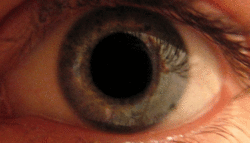
Pupillary response is a physiological response that varies the size of the pupil between 1.5 mm and 8 mm, [1] via the optic and oculomotor cranial nerve.
A constriction response (miosis), [2] is the narrowing of the pupil, which may be caused by scleral buckles or drugs such as opiates/opioids or anti-hypertension medications. Constriction of the pupil occurs when the circular muscle, controlled by the parasympathetic nervous system (PSNS), contracts, and also to an extent when the radial muscle relaxes.

A dilation response (mydriasis), is the widening of the pupil and may be caused by adrenaline; anticholinergic agents; stimulant drugs such as MDMA, cocaine, and amphetamines; and some hallucinogenics (e.g. LSD). [3] Dilation of the pupil occurs when the smooth cells of the radial muscle, controlled by the sympathetic nervous system (SNS), contract, and also when the cells of the iris sphincter muscle relax.

The responses can have a variety of causes, from an involuntary reflex reaction to exposure or inexposure to light—in low light conditions a dilated pupil lets more light into the eye—or it may indicate interest in the subject of attention or arousal, sexual stimulation, [4] uncertainty, [5] decision conflict, [6] errors, [7] physical activity [8] or increasing cognitive load [9] or demand. The responses correlate strongly with activity in the locus coeruleus neurotransmitter system. [10] [11] [12] The pupils contract immediately before REM sleep begins. [13] A pupillary response can be intentionally conditioned as a Pavlovian response to some stimuli. [14]
Some humans have the ability to exert direct and voluntary control over their iris sphincter muscles and dilator muscles, granting them the ability to dilate and constrict their pupils on command, regardless of lighting condition and/or eye accommodation state. [15] However, this ability is very rare, and its potential use or advantages are unclear.
The latency of pupillary response (the time in which it takes to occur) increases with age. [16]
In ophthalmology, intensive studies of pupillary response are conducted via videopupillometry. [17]
Anisocoria is the condition of one pupil being more dilated than the other.


| Constriction (Parasympathetic) | Dilation (Sympathetic) | |
|---|---|---|
| Muscular mechanism | Relaxation of iris dilator muscle, activation of iris sphincter muscle | Activation of iris dilator muscle, relaxation of iris sphincter muscle |
| Cause in pupillary light reflex | Increased light | Decreased light |
| Other physiological causes | Accommodation reflex | Fight-or-flight response, sexual arousal |
| Corresponding non-physiological state | Miosis | Mydriasis |